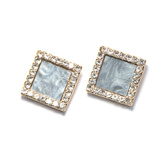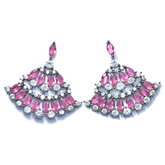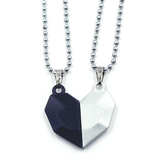The History of Jewellery: From Ancient Treasures to Modern Times
Jewellery has adorned human civilization for millennia, serving as symbols of status, culture, and personal expression. From the ancient civilizations of Egypt and Mesopotamia to the contemporary designs of today, the history of jewellery is a tale woven with innovation, artistry, and cultural significance. Join us as we embark on a journey through time, exploring the evolution of jewellery from ancient treasures to modern elegance.
Ancient Civilizations:

|
Civilization |
Time Period |
Jewellery Styles |
|
Egypt |
3000 BCE - 30 BCE |
Gold, Lapis Lazuli, Scarab Beetles |
|
Mesopotamia |
3500 BCE - 500 BCE |
Beads, Cylinder Seals, Filigree |
|
Indus Valley |
3300 BCE - 1300 BCE |
Bead Necklaces, Gold Ornaments |
|
Ancient Greece |
800 BCE - 146 BCE |
Laurel Wreaths, Diadems, Fibulae |
|
Rome |
753 BCE - 476 CE |
Cameos, Intaglios, Torcs |
Here’s more detail if you want to know more or you can just jump into the next section of Medieval Period, so Let’s start with Egypt:
Ancient Egypt is renowned for its exquisite jewellery crafted from precious metals like gold and adorned with colorful gemstones such as lapis lazuli and turquoise. Jewellery held immense cultural and religious significance, with pieces often featuring motifs of gods and symbols of protection like the scarab beetle. Intricate amulets, rings, and pendants were worn not only as adornments but also as talismans to ward off evil.
In Mesopotamia, jewellery was crafted using a variety of materials including gold, silver, and semi-precious stones. Beads made from materials like carnelian and lapis lazuli were popular, as were intricately carved cylinder seals used for stamping impressions onto clay tablets. Filigree work and granulation techniques showcased the advanced craftsmanship of Mesopotamian artisans, with jewellery often worn as symbols of wealth and status.
The ancient Indus Valley civilization produced jewellery characterized by its simplicity and elegance. Bead necklaces made from materials such as terracotta and gold were popular adornments, while gold ornaments like earrings and bangles showcased the craftsmanship of Indus Valley artisans. Jewellery served as both decorative embellishments and markers of social status within the civilization.
Greek jewellery reflected the artistic and cultural achievements of the civilization, with designs inspired by mythology, nature, and geometry. Laurel wreaths, diadems, and fibulae (ancient brooches) were commonly worn, often adorned with intricate engravings and colorful gemstones. Jewellery played a significant role in Greek society, with pieces given as offerings to gods, rewards for athletic victories, and symbols of marital status.
Roman jewellery was characterized by its opulence and diversity, with materials ranging from gold and silver to precious gemstones like pearls and emeralds. Cameos and intaglios carved from gemstones became popular during this period, depicting scenes from mythology and portraits of prominent figures. Torcs, or rigid necklaces, were worn by both men and women as symbols of status and wealth.
Medieval Period:

|
Period |
Time Frame |
Jewellery Trends |
|
Byzantine |
330 CE - 1453 CE |
Enamel Work, Religious Icons |
|
Islamic |
7th - 19th Century |
Calligraphy, Geometric Patterns |
|
Medieval Europe |
5th - 15th Century |
Gothic and Renaissance Styles |
Here’s more detail if you want to know more or you can just jump into the next section of Renaissance to Modern Era, so Let’s start with Byzantine:
Byzantine jewellery during the Medieval Period represented a synthesis of cultural richness and religious fervor. The Byzantine Empire, with its capital in Constantinople, was a melting pot of influences from the Eastern Roman Empire and beyond. Byzantine jewellery was renowned for its intricate craftsmanship, often featuring elaborate designs in gold and silver adorned with precious gemstones. Enamel work, particularly cloisonné, was a hallmark of Byzantine jewellery, with vibrant colors and intricate patterns adorning pieces ranging from rings and bracelets to religious icons. Moreover, religious symbolism was pervasive in Byzantine jewellery, with Christian motifs such as crosses, saints, and biblical scenes commonly depicted, reflecting the empire's deep ties to Christianity and its role as a bastion of Eastern Orthodox faith.
Islamic jewellery during the Medieval Period was a testament to the region's rich artistic heritage and cultural diversity. Spanning from the 7th to the 19th century, Islamic jewellery encompassed a wide range of styles influenced by various Islamic dynasties and regions. Geometric patterns, arabesques, and calligraphic inscriptions were prominent features of Islamic jewellery, reflecting Islamic principles of symmetry, unity, and spirituality. Craftsmen employed techniques such as filigree, granulation, and inlay to create intricate designs on gold, silver, and precious gemstones. Islamic jewellery served not only as adornment but also as a means of expressing social status, wealth, and cultural identity, with pieces ranging from elaborate royal commissions to everyday wear for men and women alike.
Medieval Europe witnessed a diverse array of jewellery styles influenced by the Gothic and Renaissance movements. In the Gothic period, jewellery design was characterized by its ornate and intricate nature, mirroring the architecture of the era. Elaborate pieces featuring intricate filigree work, enamel, and gemstones adorned the nobility and clergy, serving as symbols of wealth, status, and piety. Religious motifs such as crosses, angels, and saints were common, reflecting the deeply religious nature of medieval society. With the advent of the Renaissance, jewellery design underwent a transformation, embracing classical motifs and a newfound appreciation for natural beauty. Pearls, cameos, and gemstones became popular adornments, with jewellery reflecting the humanist ideals of the era. Renaissance jewellery was characterized by its elegance, refinement, and attention to detail, embodying the spirit of artistic innovation and cultural revival that defined the period.
Renaissance to Modern Era:

|
Era |
Time Frame |
Jewellery Characteristics |
|
Renaissance |
14th - 17th Century |
Pearl, Gemstone, and Enamel Decorations |
|
Baroque |
17th - 18th Century |
Ornate, Bold Designs, Rococo Influences |
|
Victorian |
19th Century |
Sentimental and Symbolic Jewellery |
|
Art Nouveau |
Late 19th - Early 20th Century |
Nature-Inspired Motifs, Whiplash Lines |
|
Art Deco |
1920s - 1930s |
Geometric Shapes, Symmetry, Jazz Age Influence |
|
Modern Era |
20th Century onwards |
Minimalism, Experimental Designs, Sustainable Materials |
Here’s more detail if you want to know more, so Let’s start with Renaissance:
Renaissance (14th - 17th Century):
During the Renaissance, jewellery experienced a revival of classical art and culture, leading to a transformation in design aesthetics. Characterized by elegance and refinement, Renaissance jewellery embraced motifs inspired by ancient Greek and Roman art, such as cameos, intaglios, and motifs of nature. Pearls, diamonds, and colored gemstones adorned intricate pieces, reflecting a newfound appreciation for beauty and craftsmanship. Renaissance jewellery symbolized not only wealth and status but also intellectual and artistic pursuits, embodying the humanist ideals of the era.
Baroque (17th - 18th Century):
The Baroque period heralded an era of exuberance and grandeur in jewellery design. Emerging in the 17th century, Baroque jewellery was characterized by its bold, ornate designs and lavish use of gemstones and pearls. Elaborate pieces featuring intricate scrollwork, curvilinear forms, and asymmetrical compositions reflected the dramatic and theatrical sensibilities of the Baroque era. Baroque jewellery symbolized power, wealth, and status, serving as ostentatious displays of opulence for the nobility and royalty of the time.
Victorian (19th Century):
The Victorian era saw jewellery evolve into a medium for expressing sentimentality and symbolism. Queen Victoria's love for her husband, Prince Albert, popularized mourning jewellery adorned with black enamel and gemstones, reflecting the era's preoccupation with death and remembrance. Sentimental motifs such as hearts, flowers, and love knots adorned lockets, brooches, and bracelets, serving as tokens of affection and emotional connection. Victorian jewellery reflected the romantic ideals of the era, emphasizing love, fidelity, and family.
Art Nouveau (Late 19th - Early 20th Century):
Art Nouveau emerged as a radical departure from traditional jewellery design in the late 19th and early 20th centuries. Inspired by nature and the natural world, Art Nouveau jewellery featured flowing, organic forms and motifs such as flowers, insects, and vines. Crafted from precious metals such as gold and silver, Art Nouveau jewellery showcased innovative techniques such as enamelwork, plique-à-jour, and millefiori, creating pieces that resembled miniature works of art. Art Nouveau jewellery represented a rejection of industrialization and mass production, celebrating individuality, creativity, and craftsmanship.
Art Deco (1920s - 1930s):
Art Deco, originating in the 1920s and 1930s, was characterized by its sleek, geometric designs and bold aesthetic. Influenced by the machine age, Art Deco jewellery embraced symmetry, clean lines, and geometric shapes such as circles, squares, and triangles. Precious metals such as platinum and white gold were favored, often adorned with diamonds, onyx, and other contrasting gemstones. Art Deco jewellery reflected the optimism and glamour of the Jazz Age, embodying the spirit of modernity, progress, and luxury.
Modern Era (20th Century onwards):
In the modern era, jewellery design has become more diverse and inclusive, reflecting the changing tastes and values of contemporary society. Minimalist styles, characterized by clean lines and simplicity, have gained popularity alongside experimental designs that push the boundaries of traditional craftsmanship. Sustainable materials and ethical sourcing practices are becoming increasingly important considerations for both designers and consumers, reflecting a growing awareness of environmental and social issues. From bespoke creations to mass-produced pieces, modern jewellery encompasses a wide range of styles, materials, and techniques, reflecting the diversity and dynamism of the global jewellery market.
Conclusion:
From the opulent treasures of ancient civilizations to the sleek designs of the modern era, jewellery stands as a testament to the ever-evolving tapestry of human civilization. It serves as more than mere adornment; it encapsulates the essence of society, culture, and technological advancements through the ages. Each piece of jewellery tells a story, weaving together the threads of human creativity, craftsmanship, and expression.
Pointers:
- Historical Evolution: Trace the evolution of jewellery from ancient civilizations such as Egypt, Mesopotamia, and Indus Valley, showcasing how materials, techniques, and designs evolved over time.
- Cultural Significance: Explore the cultural significance of jewellery across different civilizations, from symbolic representations of status and power to religious and spiritual meanings.
- Technological Advancements: Highlight how technological advancements, such as the discovery of new materials or innovative crafting techniques, have influenced jewellery design and production.
- Artistic Expression: Discuss how jewellery serves as a medium for artistic expression, allowing artisans to convey intricate details and convey messages through their creations.
- Socioeconomic Factors: Consider the impact of socioeconomic factors on jewellery design and consumption, from the rise of luxury markets to the democratization of fashion through mass production.
- Global Influence: Examine how jewellery styles and trends have transcended geographical boundaries, influencing and being influenced by diverse cultures and civilizations.
- Contemporary Trends: Discuss current trends in jewellery design, emphasizing the fusion of traditional craftsmanship with modern aesthetics, sustainability initiatives, and the use of technology in jewellery production.
By delving into the history of jewellery, we gain a deeper appreciation for its timeless beauty and cultural significance, recognizing it as more than just a fashion accessory but as a reflection of the human spirit throughout the ages.
References:






